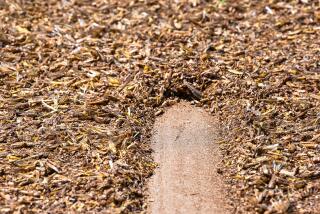Rousting Gophers to Restore Lawn Order
- Share via
Question: Gophers are destroying my lawn. Do you have any suggestions on how to get rid of them?
D.B., Santa Ana
Answer: Crescent-shaped mounds are the gopher’s classic calling card. A plugged hole will be detectable to one side of the mound. This plugged hole marks one of the lateral tunnels of the gopher burrow.
Gopher control depends on finding the main burrow. Using a “gopher probe” or a reasonably sharp metal rod, probe the ground about 8 to 12 inches from the plug side of the mound, roughly 6 to 12 inches deep.
Once your probe enters the burrow, it will suddenly drop about 2 inches. This is where you bait or set a trap.
A variety of gopher traps are available. One common type is the two-pronged pincher trap such as the Macabee. You will also see a variety of choker-style box traps.
To set a gopher trap, look for recent gopher activity based on fresh mounds of moist soil. Find the main burrow. Use a garden trowel or shovel to enlarge the tunnel enough for two traps.
Place their openings in opposite directions so you can trap the gopher coming from either end of the burrow.
Some people say they get better results if they wear gloves and rub the traps in soil or vegetation after handling them to mask any human scent.
Others bait with lettuce, carrots, apples, roasted hazelnuts or alfalfa greens. Place the bait just behind the wire trigger or flat plate of the trap. Anchor your trap with a stake so you can remove it if the gopher drags the trap deeper into the burrow.
After the trap is set, cover the opening with a board, sod or other material to exclude all light. Check your traps frequently and reset if necessary.
If you haven’t caught a gopher in three days, reset in another location.
Baiting with toxins is another option, but use extreme caution if you have children or pets.
The key is to place the bait in the main tunnel, not the lateral ones. Probe, find the main burrow, enlarge the opening by rotating the probe, follow label directions and place the bait with a spoon or other tool used only for this purpose. Several types of bait are available.
Multiple bait placements in the burrow increase chances for success. Hand-held bait applicators are available but quite costly. Bait, exclude the light and check for new mounds.
If gophers appear for more than two days after baiting, or for more than 10 days after anticoagulant baiting, rebait or consider trapping.
Once you have your gopher problem under control, monitor the area regularly for reinfestation. This is done by knocking down the mounds after baiting or trapping and looking for new mounds.
For further information on pocket gophers, check out the University of California pest note, publication No. 7433, on the World Wide Web at https://www.ipm .ucdavis.edu.
Have a problem in your yard? University of California Cooperative Extension (UCCE) Master Gardeners are here to help. These trained and certified horticultural volunteers are dedicated to extending research-based, scientifically accurate information to the public about home horticulture and pest management. They are involved with a variety of outreach programs, including the UCCE Master Garden hotline, which provides answers to specific questions. You can reach the hotline at (714) 708-1646 or send e-mail to
ucmastergardeners@yahoo.com. Calls and e-mail are picked up daily and are generally returned within two to three days.





